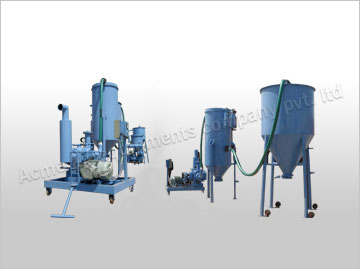A pneumatic conveying system transports dry powders, granular materials, and other liquid bulk products through a sealed pipeline. The reason why this material is transferred through the powder conveying system comes from a combination of high pressure differential, a flow of compressed gas, like oxygen or nitrogen, and the directional movement of a fluid, like air or water. This system is the most commonly used method to convey liquids or gaseous materials in various industries. For instance, it is used to move powdered materials, chemicals, fluids, and gels across industrial assembly lines.
Most pumps that use a pneumatic conveying system are rotary type pumps. Rotary pumps are used to push or pull a fluid or a compound through a manifold of cut off vents and intake ports. The intake ports in a rotary pump can either be closed or open. Some types of rotary pumps contain a solenoid to mechanically initiate the flow of the fluid or compounds through the manifold.
In the operation of a pneumatic conveying system, a material is pumped at high pressure through a manifold of intake ports in a very controlled manner. Once the material is in the pipe, the manifold is then sealed at the appropriate location preventing the escape of the heated or cold gases or the solid or liquid material from the inside of the pipe. At this point, a pressure differential exists between the inside of the pipe and the pressure differential outside the pipe in powder conveying systems.

Depending on the size and viscosity of the material being conveyed, a number of different options are available for the conveyor. The most common system employed in the United States is the flexible screw conveyor. This system comprises a number of long, flexible pipes, that are placed through a series of holes or openings in a metal die; a thin metal cylinder (the conveyor rod) is then connected to the inside of the pipe or cylinder via a flexible screw threaded like a lock bolt. Once this is connected to the rod, the conveyor or cylinder is able to flex into various shapes depending upon the desired size and shape of the material being conveyed. The conveyor is able to adjust to changes in pressure by changing the angle of its shafts.
There are a number of different benefits associated with pneumatic conveyors. These benefits typically require one or more pumps in order to operate effectively. The size and capacity of the system will determine how many pumps will typically be required to accommodate the system. One benefit typically requires the use of less mechanical conveying systems than other systems. These typically require only a single pump in order to properly operate; these typically have an electric motor to provide the drive for the pumping action. This can reduce the amount of power that is required to operate the machinery.
A mechanical conveying system will typically require fewer man-hours of operation when compared to a pneumatic system. The conveyor drive system can reduce operating costs when compared to a pneumatic system because of the fact that there are less motors to maintain. Man hours are saved as well when using a mechanical system because there are fewer employees that need to be operating the conveyor. Another benefit is that there is less noise created in the environment when using a mechanical conveyor system. When it comes to the cost of operation, a pneumatic conveying system will typically require fewer operating hours, which means less money in the end for the business owner or company. If there are many different types of businesses that need to utilize this type of machinery, it is important to research all the options and determine which one is the best choice for the particular application that is being handled.



